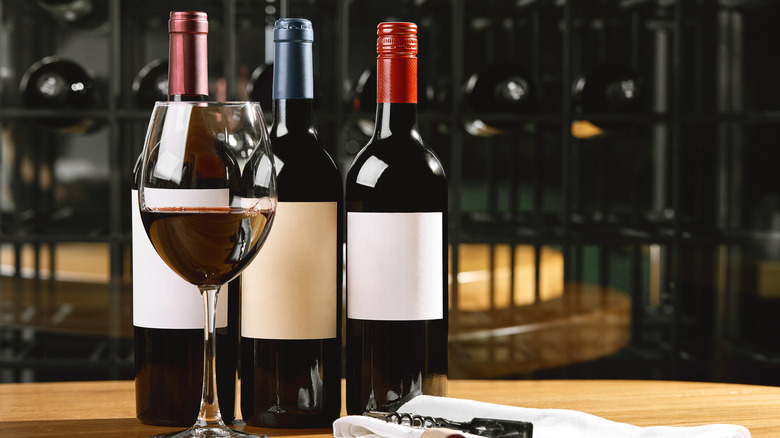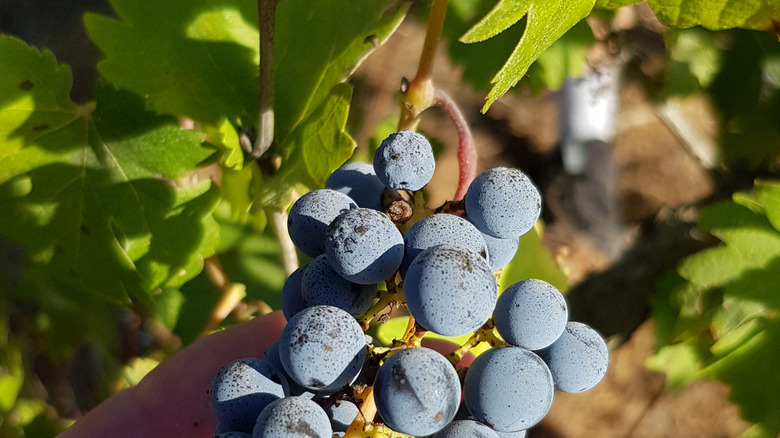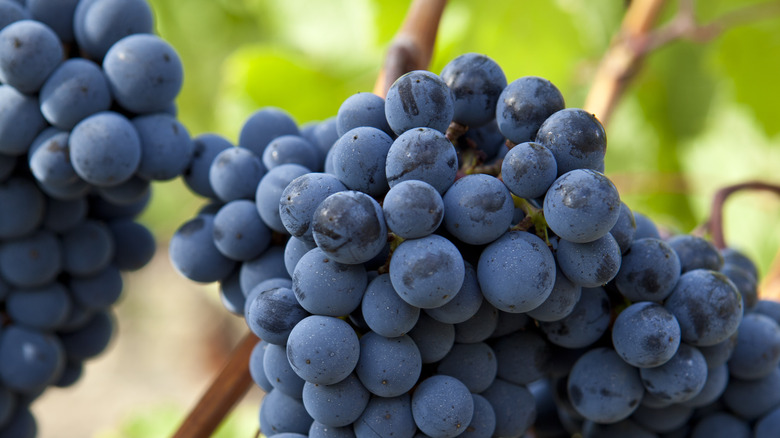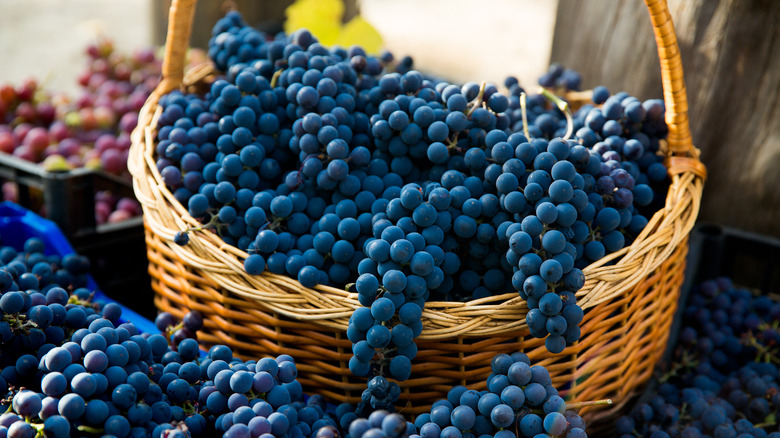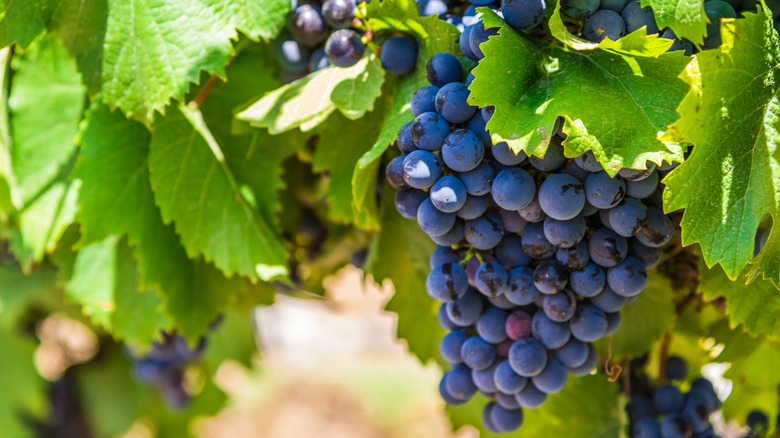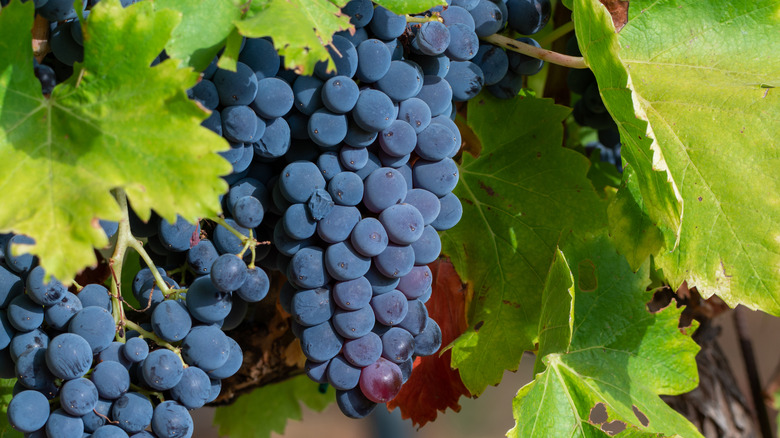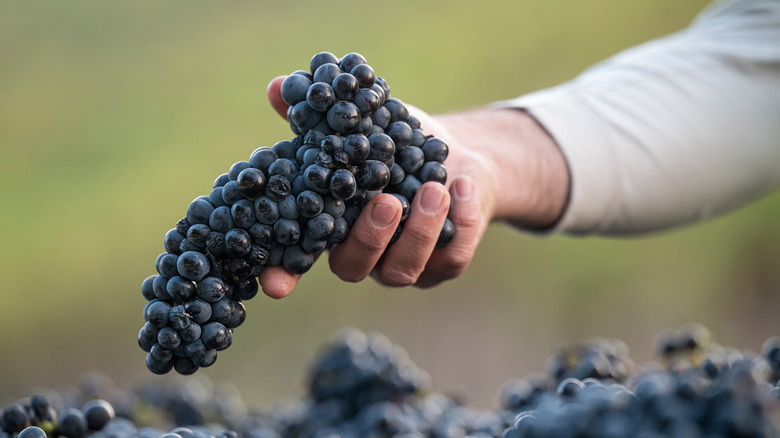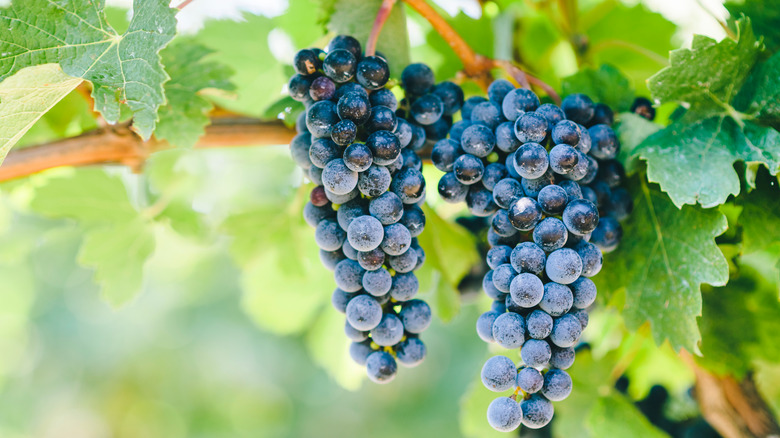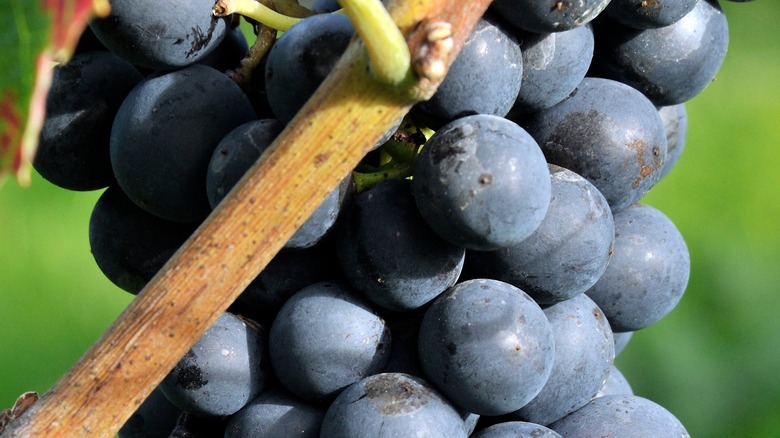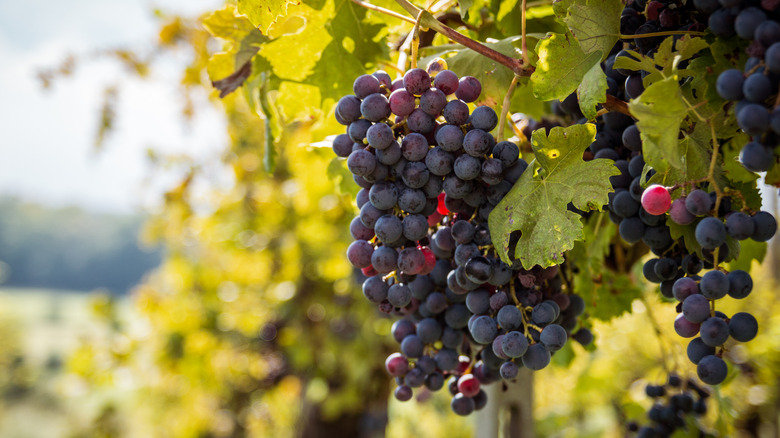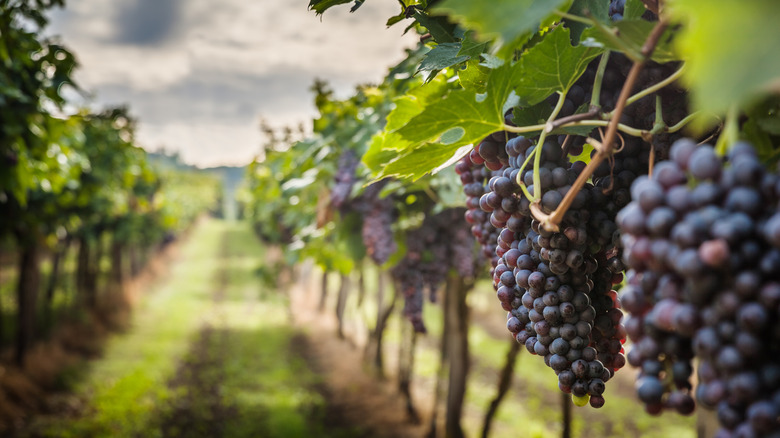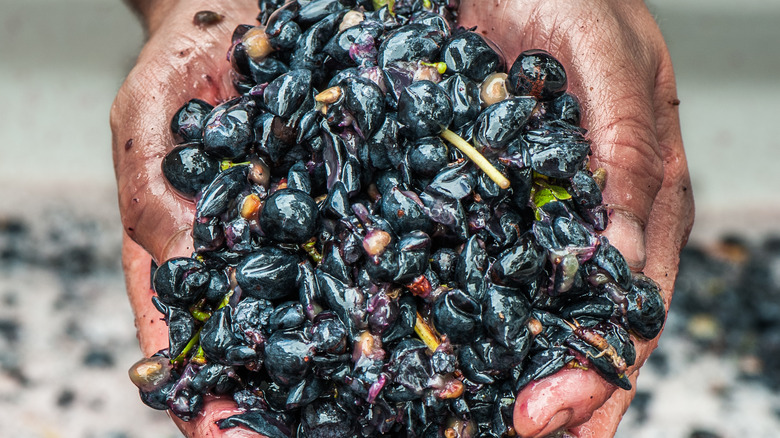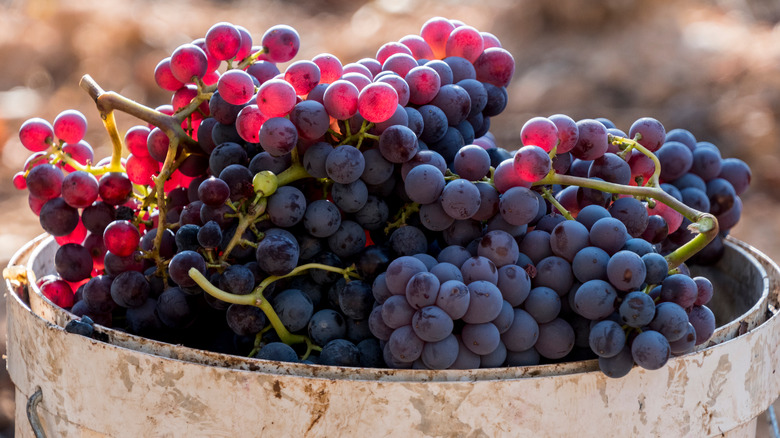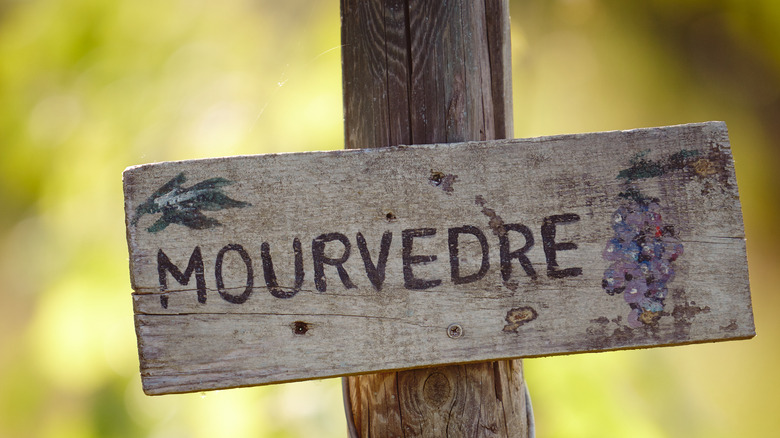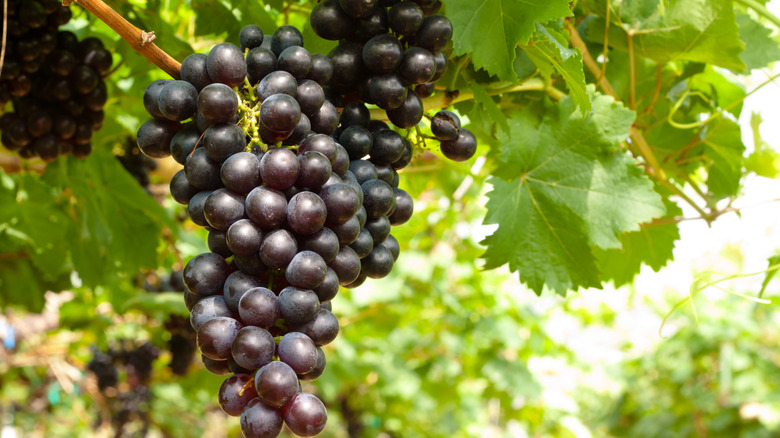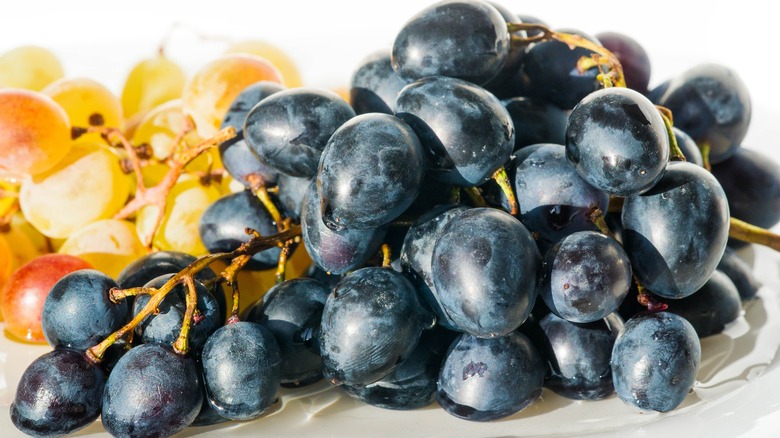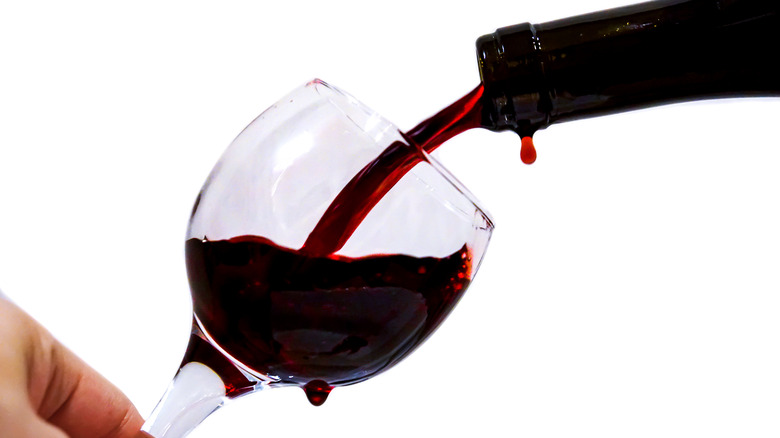Every Type Of Red Wine Explained
The world of red wine consists of an incredibly vast and varied landscape. There are at least as many styles of red wine as there are winemakers since everyone can put their own spin on the way they handle the grapes, ferment them, and store the finished product. It can all seem a bit overwhelming.
However, the single biggest clue a consumer has about what a wine will taste like comes from the type of grape that was used to make it. Merlot has characteristics familiar to all Merlot, and the same goes for Zinfandel, Pinot Noir, or any other grape type. Elements like tannins, acid level, and sweetness of a grape have similar features across the board, although harvest time and climate can have an influence. So the first step in understanding a new wine is learning what kind of grape — or grapes — go into the bottle.
Especially when it comes to European wines, producers don't list which grape types are used and instead, only refer to the wine by the geographic location the fruit was grown in. This means that a little research is needed, but it's not as bad as it seems since these regions have laws that state exactly what's permitted to be bottled under that name.
Picking out a red wine doesn't have to be complicated, and this guide will help you do exactly that.
Cabernet Sauvignon
As Forbes reports, Cabernet Sauvignon is the most planted wine grape variety in the world. For many wine drinkers, good red wine is synonymous with Cab. Originating in the Bordeaux region of Southwest France, Cabernet Sauvignon is the result of a cross between two other grape varieties: Cabernet Franc and Sauvignon Blanc (via Wine Folly). The resulting grape is full of character and capable of producing some of the world's most well-regarded and age-worthy wines.
According to Decanter, in its native Bordeaux, Cabernet is usually blended with a few other types of grapes — including its parent Cabernet Franc and world-famous Merlot — to make extremely complex red wine that is harsh and tannic in its youth but capable of aging gracefully for decades. The astringent quality that the tannins bring is exactly what allows the wine to gain in character as it gets older while still having enough structure to remain drinkable.
Cabernet has found many additional homelands beyond Bordeaux in places as far-flung as Napa Valley in California and the steep mountainsides of Chile. These new locations have cultivated the variety in the hopes of making a name for themselves on the international market. Wherever it's from, a typical Cabernet Sauvignon is dark and rich. Some flavors and aromas associated with this wine include blackcurrant, tobacco, blackberry, plums, potpourri, and cocoa.
Merlot
Merlot — or little blackbird in French — also hails from the Bordeaux region. It is a major player in the local blends where its lushness and soft tannins mellow out the more robust Cabernet Sauvignon; many drinkers describe a Merlot wine as silky or smooth.
Thanks to the 2004 movie "Sideways," one of the defining characteristics of Merlot has been its uncoolness. In the movie, Paul Giamatti's character really hates the variety, and moviegoers emulating him caused sales of Merlot to crater. However, over a decade later the grape is finally recovering from its huge drop in popularity (via Bloomberg).
Like Cabernet Sauvignon, Merlot is a descendant of Cabernet Franc. This leads to similarities that sometimes prevent experts from distinguishing between the two when they are tasted blind (per Wine Enthusiast). Because it is approachable and softer than other serious reds, it is often cited as a good beginner wine for those dipping their toes into dry red wines for the first time.
According to VinePair, descriptions of Merlot are rife with talk of plums, blackberry, cocoa, mint, and violets. When a wine has been aged for a long time in oak it usually gets descriptors like vanilla and spiciness — both characteristics that come from contact with new oak.
Pinot Noir
Pinot Noir comes from the Burgundy region of France. It is a thin-skinned, delicate grape that produces wines that are typically lighter in color and body (or mouthfeel) than most other reds. For this reason, it can be a nice place to begin your red wine journey since a dark, tannic style can be intimidating for beginners. Common tasting terms associated with Pinot Noir include cherries, anise, mushrooms, and violets (via Wine Enthusiast).
In Burgundy, the old real estate adage holds particularly true: It's all about location, location, location. Here, probably more than anywhere else in the world, the specific vineyards matter in determining the finished product's qualities. This concept is called terroir and it combines the different variables that influence grapes as they grow: climate, soil composition, sun exposure, slope, longitude, latitude, etc. In Burgundy, Pinot tends to be earthy, complex, and subtle, though elsewhere Wine Enthusiast explains it is typically a fruity, lightweight wine that goes down easy.
It tends to thrive in climates that aren't too hot since the thin skin can cause the fruit to dry out or acquire a cooked or jammy flavor — undesirable to a purist — when exposed to too much heat. Some regions in California specializing in this finicky variety include the Russian River Valley and Carneros (per Forbes). Both of these areas have the cooler climate necessary to make interesting and delicate wines. In addition, Oregon Pinot has developed into a true benchmark style.
Malbec
Another grape with roots in Bordeaux, Malbec produces a dark, rich red wine. In its home region it is typically blended with more famous grapes like Cabernet Sauvignon and Merlot, but in the outlying region of Cahors — where it's known as Côt — this grape gets star billing (per The Spruce Eats). However, despite French antecedents, Malbec has found a new spiritual home in Argentina. Considered the national grape, it covers more than 100,000 acres (via Forbes), primarily in the region of Mendoza where high elevation adds complexity and tempers the sometimes extreme heat of Argentina's desert landscape.
Malbec is widely considered a wine for Millenials (per WLRN) since it has a lot of qualities younger people appreciate such as obvious fruitiness and smooth tannins, and it is decidedly not their parents' Merlot or Cab. Malbec also doesn't need to age forever to be palatable, something that younger people — who typically lack the facilities for long-term storage — find convenient.
It is particularly well-suited for drinking with another Argentine specialty: grilled meat (via The Wall Street Journal). The dark, earthy tones of the wine sync up with the fiery flavors of meat slow-roasted over smoky embers. Typical flavors of Malbec include dark fruit, tobacco, mint or menthol, and earth.
Syrah or Shiraz
Although it goes by two different names, they both refer to the same grape. Syrah, as it's known locally, comes from the Rhône Valley in southern France. It plays a part in some of the best — and most expensive — wines in the whole country. In the northern subregions of Hermitage and Côte-Rôtie, it makes a powerful, concentrated, dark red wine that can age for decades. These deeply savory reds command a lot of respect from experts and set the benchmark for this style all over the world (per The Grape Grind).
Particularly in Australia, where it has become the signature wine of the country, this grape goes by the name Shiraz. While it may be the same grape, thanks to drastically different growing conditions, it exhibits very distinct qualities. Australian Shiraz tends to be inky, bold, and high in alcohol — a consequence of higher average temperatures Down Under. As Decanter remarks, Australians have been able to experiment with this grape since they do not have the same weight of traditions the French do when making wine.
Wine Enthusiast explains that winemakers tend to label cool climate wines in line with the French style as Syrah, while Australian styles from warmer areas go by Shiraz. Most tasters detect dark fruits in the wine, but the chief note that is picked up — no matter where the grapes are grown — is black pepper (via Wine Folly).
Nebbiolo
Although it does not have the international reputation that many grapes of French origin enjoy, this Italian variety makes some of the greatest red wines in the world. With a name that means foggy (per Wine Spectator), this grape thrives in its native Piedmont in northwestern Italy. The most famous types of wine made from Nebbiolo are the vaunted Barolo and Barbaresco, both sturdy, powerful wines that improve and soften with age.
The grape's thick skin means that it needs lots of sun exposure to fully ripen, so growers prefer to situate it on hills to maximize the time it spends in direct sunlight. As VinePair explains, in the Northern Hemisphere the south-facing side of a slope spends the most time in the sun.
Thanks to the thick skins, these wines are particularly tannic, which once meant you needed to wait decades for them to mellow. However, as Wine Enthusiast explains, that is no longer the case and a newly pressed Barolo can be ready for drinking in as few as seven years. That's not a short amount of time, but it's definitely more achievable than the 20 years previously given as a minimum.
The famous scent of tar and roses that experts find in a glass of Nebbiolo may seem strange and even off-putting, but enthusiasts swear by the intoxicating allure of this tough grape.
Zinfandel
While most California wine success stories start in France, Zinfandel comes from a different European country, not often associated with wine: Croatia, where it is known as Crljenak (per the Grape Grind). It eventually made its transition to the U.S. by way of immigrants in the 19th century. A southern Italian grape that goes by the name of Primitivo has also been proven to be the same variety.
Although premium California wines are largely thought to begin and end with Cabernet Sauvignon, Zinfandel has formed a unique place within American viticulture. It has become native in the Golden State and happens to be the only grape variety with an entire festival based around it (via Wine Folly).
Jamminess — sometimes a fault in other wines — is one of the defining characteristics of Zinfandel, thanks to its naturally low acidity and the great ripening power of California sunshine. Many producers like to stick the designation of old vines on their bottles to draw in consumers. However, VinePair attests that the designation has no legal value.
Zinfandel is the perfect wine to drink with a classic American barbeque. The spicy rich and fruity flavors of the wine pair perfectly with the complexity of a smoky, sweet hunk of meat.
Cabernet Franc
Cabernet Franc, though substantially lesser known than some of its more famous offspring like Cabernet Sauvignon and Merlot, still manages to make excellent wine. The grape originates in the extreme southwest of France, in Basque country (via MasterClass), and is one of the acceptable varieties in classic Bordeaux blends.
It has also carved out a home for itself in more northern areas of France such as the Loire Valley, where it is bottled as a single varietal wine under various local names such as Chinon and Bourgueil. Here, Cab Franc benefits from a cooler climate since it tends to ripen earlier than other, heavier red grapes (per Loire Valley Wine).
This grape type has also found a warm reception in the New York Finger Lakes region where, again, the colder temperatures allow a slow maturation for maximum flavor extraction. In fact, it is responsible for some of the region's best dry red wines. As per The New York Times, these wines are pleasantly tart, low in alcohol, and mineral-driven. All these qualities make them approachable and perfect to drink with food.
In terms of style, a Cabernet Franc wine typically falls in a happy medium between the beefy Cabernet Sauvignon and the featherweight Pinot Noir. Wines made from this grape are likely to show flavors of red berries, cranberry, and subtle spicy notes (via VinePair).
Gamay
Gamay is usually considered to be less serious than other red wine grapes. Its homeland of Beaujolais in eastern France has long been considered a source of simple, quaffable reds that are good for washing down hearty country cooking — and not much else. As The Spruce Eats explains, it is often associated with Thanksgiving because it pairs well with a spread of holiday food.
In Beaujolais, there are multiple rungs of quality, with top-tier wines named after the specific villages they come from; Morgon and Fleurie are familiar to dedicated wine drinkers. However, most consumers associate the name with Beaujolais Nouveau, a newly-pressed wine that by French law, cannot be released before the third Thursday in November (another factor that makes it perfect for Thanksgiving).
Unfortunately, by the time the New Year rolls around, the fresh-pressed stuff is past its prime. The other types of Beaujolais have much more potential — and longevity. Many wine writers compare Gamay to Pinot Noir since both are lighter-bodied red wines. The difference comes down to Gamay being more rustic in style while Pinot tends to be more complex and longer-lasting (via VinePair).
The typical aromas in a glass of Gamay wine include cranberries, cherries, and raspberries. The tart edge of this wine invites a cooler temperature than most red wines, and it benefits from spending half an hour in the fridge before being consumed.
Barbera
Sometimes referred to as the Beaujolais of Italy, Barbera makes a relatively tart, food-friendly wine (via MasterClass). It shares the region of Piedmont with its more aristocratic neighbors of Barolo and Barbaresco — both made from Nebbiolo — but it is definitely the country cousin of the group (via Food & Wine).
Barbera was once the third most planted red grape variety in Italy (per MasterClass), commonly blended with heavier reds from the South to balance flavors. It was not considered special enough to export but the wine was still consumed locally. However, as prices for the better known Barolo and Barbaresco skyrocketed past what most consumers could afford, Barbera stepped in to fill a void and provide an easier drinking, less expensive Piedmontese alternative. Its acidity and likable flavor profile have since endeared it to a new generation of drinkers. The fact that it matures much faster than these other wines is just another reason to like Barbera.
When drinking a glass of Barbera, you can expect aromas of tart cherry, strawberry, and blackberry (via Wine Folly). These wines are usually fruit-forward which rewards drinking them earlier; they're not meant for aging. Although the grape is not very popular outside of Italy, Amador County in California has made something of a name for itself by producing Barbera. Thanks to the state's warmer climate, these wines are fuller-bodied with more lush fruit than their Italian counterparts (via Wine Traveler).
Sangiovese
This impressive grape whose name means blood of Jupiter comes from Tuscany, Italy. It is the most largely planted grape variety in the country (via The Spruce Eats), although it does not enjoy a wide distribution internationally.
Sangiovese is somewhat tricky to grow because it is not only thin-skinned but slow to mature. This means the delicate grapes need to hang on the vine — exposed to the elements — for a long time in order to fully develop and reach their maximum potential. The resulting wine is high in acid and tannins, with lots of color extraction — hence the comparison to blood. Per The Spruce Eats, most tasters discover dark fruit and tobacco aromas in the glass.
The most famous wine made with Sangiovese is the world-famous Chianti, which has enjoyed a tremendous reputation for centuries. However, as Wine Enthusiast explains, it fell victim to its own success when growers attempted to meet soaring demands in the 1970s by planting on inferior land and bottling substandard wine under the name Chianti.
Trying to break free of this stigma — as well as what they saw as overly restrictive wine laws of Italy — forward-thinking winemakers in Tuscany took their beloved Sangiovese and blended it with international varieties like Cabernet Sauvignon to create wines that have since been dubbed Super Tuscans (per Wine Spectator). These wines enjoy some of the best reputations — not to mention the highest prices — in all of Italy.
Tempranillo
Tempranillo is the number one planted grape variety in its native Spain. It is the principal variety associated with Spain's most famous wine region of Rioja where it makes dark, rich red wine that is capable of aging for years. In the region of Ribera del Duero, where it is also the most important component of the wines, it is referred to as Tinto Fino (via Decanter).
Rioja wines are fruity and bright when young but as they age start to take on darker, more complex flavors that reward the patience needed to store them. The Spanish like to age their wines in American oak barrels which the Kitchen explains imparts strong vanilla flavors. Because of this fact, many bourbon drinkers find these wines enjoyable since they both share a strong American oak influence.
Tempranillo has been around for over 3,000 years and was brought to Spain by the Phoenician Greeks in their sea voyages around the Mediterranean (per Wine Folly). This variety has made its way across the entire Iberian peninsula, and Portuguese winemakers — who call it Tinta Roriz — add it to blends that make up their beloved Port.
Younger Tempranillos are known for having bright red fruit notes and lots of tannins, Wine Folly notes. Meanwhile, older mature examples are often said to be softer with aspects of dusty leather, which sounds strange but is oddly delicious.
Grenache or Garnacha
Grenache is the French name for Garnacha, a grape that originally comes from Spain, Wine Folly explains. Whatever you call it, this variety is responsible for some of the greatest red wines around. Its dark, wild flavors captivate lovers of gutsy red wine the world over. Distinctive aromas of dried fruit with plentiful spicy notes often give away the game when tasted blind.
In France, you are most likely to find this grape in the southern portion of the Rhône Valley, where it is typically blended with other varieties to form savory red wines. The most famous is Châteauneuf-du-Pape, named after the popes who resided there in the 14th century (per Forbes). Less vaunted local wines, such as entry-level Côtes du Rhône, are also made primarily of Grenache.
Over in Spain, the country's beloved Garnacha — which locals are justly proud of — is the main grape variety in the relatively warm region of Calatayud. Here, late-ripening Garnacha has plenty of time to fully mature on the vine; as a consequence, these wines can sometimes push 15% alcohol (per Wine Folly). Meanwhile, the remote, mountainous region of Priorat does wonderful things with Garnacha. Blended with other native grapes, the wines here are powerful with great depth (via Decanter).
Mourvèdre
Another grape with different names depending on where it's grown: Mourvèdre is the name in France, in its native Spain it goes by Monastrell, and in Australia it is Mataro. This is a powerful grape that makes a strong, darkly colored wine. As The Wine Cellar Insider explains, it can raise the alcohol content in any blend it is added to. Its home in France is the Rhône Valley where it is usually blended with other grapes. In fact it is so commonly mixed with Grenache and Syrah that wines composed of this blend usually go by the shorthand GSM (per Wine Enthusiast).
The small region of Bandol in the south of France requires that its red wines contain at least 50% Mourvèdre — but the best producers always add more — making this area one of the very best places to find top quality wine made with the grape. As Kermit Lynch expounds, this part of France has the perfect conditions for getting the absolute most out of Mourvèdre.
The dark, wild flavors of this wine are suitable to pair with earthy, rustic food and include dark fruit such as roasted plums as well as resinous, oily herbs like oregano. Bandol reds are a traditional accompaniment to many lively Provençal dishes, liberally seasoned with garlic and olive oil.
Petite Sirah
This confusingly named grape type is not a smaller version of Syrah. However, it is a cross between Syrah and the very obscure grape Peloursin (per Vindulge). A French botanist discovered the variety growing in southern France, but it really thrived once it crossed the Atlantic and reached California. Currently, the Golden State has the most plantings of Petite Sirah worldwide with over 10,000 acres, and it is also grown in Australia.
Petite Sirah is a grape that makes a dark, inky red wine. This darkness indicates a particularly high level of antioxidants (via Wine Folly), so those who drink wine for their health should take note! Some beginners to wine find it unpalatably heavy and rich, but those who crave a weighty, dry wine can't seem to get enough. Typical flavors associated with Petite Sirah include smoke, coffee, spices, and licorice. If you want an intense wine, this is the ticket.
Even if it's not for everyone, this variety is a great choice when you need a bottle of big red wine to go with a meal. This intense wine makes a good pairing for equally powerful food like Mexican chicken mole or meaty braises. The Wine Cellar Insider recommends it as an accompaniment to barbeque, where the dense complexity can be matched by smoky, savory goodness.
American Wines
All of the wines that have been discussed so far have one element in common. They are all technically the same species: vitis vinifera. Usually called the European wine grape, vitis vinifera has thousands of subspecies, both red and white. However, there is another grape species that is perfectly capable of making wine: vitis labrusca (per Wine Folly).
As Atlas Obscura explains, when European colonists came to the so-called New World, they found native grapes growing wild. They did what made sense to them and tried to make wine. However, they were put off by the particular flavor of these native varieties, which even back in the 1600s were referred to as foxy or musty — terms which persist to this day.
Even though they don't get much respect from wine snobs, American varieties actually ended up saving the entire wine industry — or at least their roots did. In the late 19th century an insect native to the U.S. found its way to European soil and subsequently wreaked havoc on the wine operations of the entire continent. It wasn't until the solution was found to graft the European vines onto American rootstock — which had developed an immunity to the bug — that recovery began (via The Chicago Tribune).
Examples of red American varieties include Catawba, Concord, and Niagara. Wines made from these taste a lot more like grape-flavored candy than most European wines.
Blends
The open secret behind many of the world's great wines is that they are not the product of a single variety of grape, but a combination of several. This practice aims to coax the best qualities from each one in order to make wine that is greater than the sum of its parts. The versatility that comes from being able to tailor your wine to your taste and what's available has caused these types of wines to explode in popularity (per Food & Wine).
Although red blends are particularly popular now, they are far from being a new invention, and many classic wines and regions have been mixing different types of grapes for centuries. The most prominent example is Bordeaux — where, as Decanter explains, Cabernet Sauvignon, Merlot, Cabernet Franc, Petit Verdot, Carmenère, and Malbec are all permitted.
Other examples include classics such as Chianti, Châteauneuf-du-Pape, Côtes du Rhône, and Rioja. In fact, in all of these examples, blending different grapes has been written into the laws that govern winemaking (via Know Wines).
In more modern times, a red blend has come to refer to a smooth drinking red wine of anonymous composition that tends to be low in acid and alcohol. These blends are a great starting point for anyone new to wine since they are approachable and very fruit-forward.
